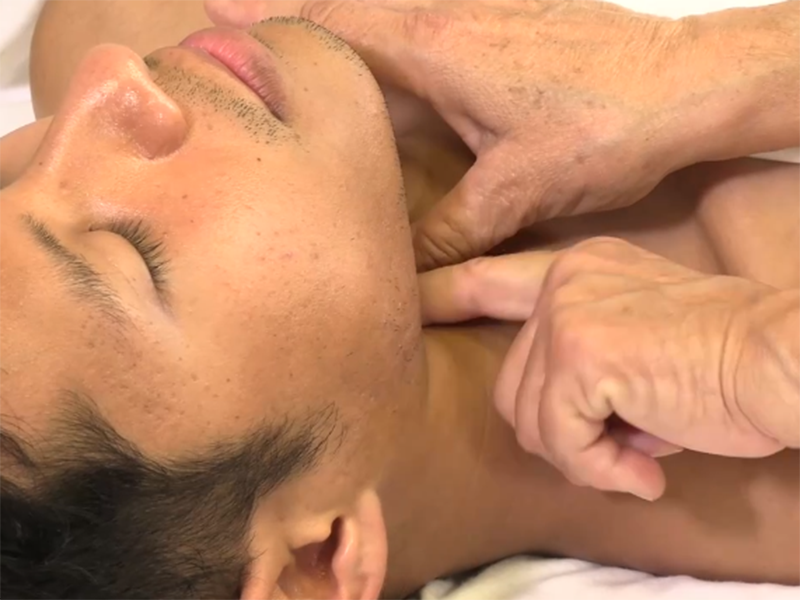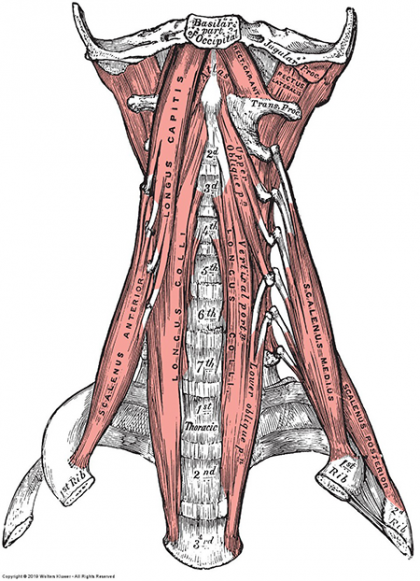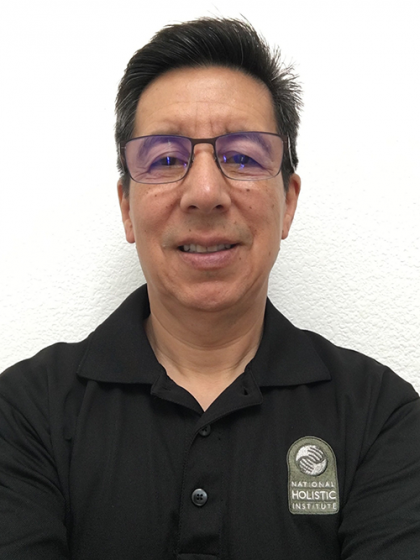NHI San Jose Grad Tony Salazar Uses Neuromuscular Therapy to Provide Relief to the Longus Colli
- Advanced Neuromuscular Therapy Program
- Amazing Alumni
- Anatomy & Physiology
- Health & Wellness
- NHI Life

Neuromuscular Therapy on the Longus Colli muscle
Tony Salazar completed the Core and Advanced Neuromuscular Therapy Programs at National Holistic Institute in San Jose. He’s been practicing in the field for over 2 years and is supporting the ANMT students by volunteering as a tutor and Teaching Assistant. We have received permission from Tony and his patient to share an account of this exciting session.
The Anatomy of the Longus Colli

The Longus Colli Muscle
Before getting into the details of the session, we will set the stage by discussing the anatomy. The main muscle that was addressed is the Longus Colli. The Longus Colli rests along the anterior surface of the spine and is deep to the pharynx. As a refresher, the pharynx is a muscular tube that connects the oral and nasal cavity to the larynx and the esophagus.
There are three parts to the Longus Colli muscle. The inferior oblique belly attaches inferiorly to the 1st, 2nd, or 3rd thoracic vertebrae and runs superiorly to the anterior tubercles of the transverse processes of the 5th and 6th cervical vertebrae. The superior oblique portion attaches anteriorly from the transverse process of the 3rd, 4th, and 5th cervical vertebrae, runs in an upward and oblique direction to the anterolateral surface of the anterior arch of the atlas, (C1). The third portion, the vertical intermediate belly, begins on the bodies of the upper three thoracic and loser three cervical vertebrae and attach to the bodies of the 2nd, 3rd, and 4th cervical vertebrae.
This deep anterior will laterally flex the neck to the same side, rotate to the opposite side, and when both contract together, they will create neck flexion.
Symptoms of a Restricted Longus Colli Muscle
In addition to the anatomy and actions of the muscle; an important component of the session we’re about to describe includes the symptoms the muscle exhibits when there are restrictions within the muscle. These deep anterior neck muscles are known as “Pseudo SCM Pain” in the 1st volume, 2nd edition of Travell & Simons’ Myofascial Pain and Dysfunction; the 3rd edition of this book refers to this group of muscles as “Tongue Pain Impersonator.”
Longus Colli and Longus Capitis trigger points are likely to create difficulty with swallowing and/or the sensation of having a lump in the throat. Typically, these sensations are present in patients that have sustained a cervical flexion-extension injury, such as whiplash. Additionally, injury to the Longus Colli can produce symptoms of a dry mouth, a sore throat without infection, a persistent tickle in the throat, or a lump in the throat with swallowing.
Clinical Success Story Using Neuromuscular Therapy
This particular session started like any other. The patient is being treated for a number of musculoskeletal conditions and has survived cancer. The patient models and there are repetitive physical demands and visual appearance runs at a premium. Tony’s assessment prior to the session included a “recent quick history, review of any chronic conditions, and recent trouble areas. Observations include posture, ROMs, and palpation. Special tests are performed as needed.”

Tony Salazar
During the session, the patient asked Tony, “what is the most unusual muscle you’ve treated?” Tony responded, “neck work, specifically related to the Longus Colli where it resides on the anterior side of the spinal vertebrae.” The patient continued the inquiry asking why the Longus Colli is unusual. Tony shared “that some patients have symptoms where they feel something is stuck in their throat, or it’s difficult to swallow.”
At this point, the patient’s eyes opened broadly and said that is the feeling they’ve been experiencing and multiple health care providers had completed examinations and tests and told this patient there was nothing wrong and it must be something they were imagining. At this point, with the approval of the patient, Tony altered the session plan.
He began to palpate the anterior neck; “acquisition of the target muscle and destination requires patience and sensitive of patient comfort…extreme care with surrounding structures and comfort of the patient.” Upon initial palpation of Longus Colli, there was a “squishy” sensation to the musculature. While most patients may feel hesitancy towards manual therapy directed at the anterior neck, this particular patient did not hesitate; however, Tony felt some unease because it was the first time he was working with this muscle on a patient. The patient expressed excitement at the possibility of relief from the symptoms they had experienced for over 10 years.
Immediate Relief & Full Resolution of Symptoms
The patient felt immediate relief and became emotional and cried happy tears after receiving the treatment. This particular treatment spanned 10 sessions to achieve full resolution of the symptoms and is now in maintenance mode.
DISCLAIMER | This article contains techniques taught in National Holistic Institute’s Advanced Neuromuscular Therapy Program and is for informational purposes only. Readers are advised to not attempt the techniques described without proper training. Doing so may result in serious physical injury. Please contact National Holistic Institute if you are interested in registering for classes.
Get the details about NHI’s Advanced Neuromuscular Therapy Program and its value in restoring function and addressing chronic pain today. Complete this form to connect with an admissions representative.